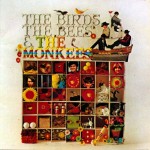The Birds, the Bees & the Buzzcocks
A song by song response to The Birds, the Bees & The Monkees by The Monkees
The Birds, the Bees & the Buzzcocks
Side One
- “Real World” from Love Bites
- “Why Can’t I Touch It?” (b-side of “Everybody’s Happy Nowadays”)
- “Fiction Romance” from Another Music in a Different Kitchen
- “Paradise” from A Different Kind of Tension
- “Everybody’s Happy Nowadays” (single a-side)
- “Something’s Gone Wrong Again” (b-side of “Harmony in my Head”)
Side Two
- “Walking Distance” from Love Bites
- “I Don’t Know What to Do With My Life” from A Different Kind of Tension
- “No Reply” from Another Music in a Different Kitchen
- “Radio Nine” from A Different Kind of Tension
- “Nostalgia” from Love Bites
- “Sixteen” from Another Music in a Different Kitchen
- “Autonomy” from Another Music in a Different Kitchen
All songs performed by Buzzcocks
All songs written by Pete Shelley, except for “Walking Distance” written by Steve Garvey and “Autonomy” written by Steve Diggle.
All tracks produced by Martin Rushent
Inspiration Album: The Birds, the Bees & The Monkees – The Monkees
Side 1
- “Dream World”
- “Auntie’s Municipal Court”
- “We Were Made for Each Other”
- “Tapioca Tundra”
- “Daydream Believer”
- “Writing Wrongs”
Side 2
- “I’ll Be Back Up On My Feet”
- “The Poster”
- “P.O. Box 9847”
- “Magnolia Simms”
- “Valleri”
- “Zor and Zam”
Mix Challenge Liner Notes
My choice of The Birds, the Bees and The Monkees as the touchstone for this mix has several reasons. During the initial run of their TV series (1966-68) The Monkees ruled my musical and cultural world. The Birds, the Bees and The Monkees was their fifth album to be released during this time, as well as being the last one that I recall thoroughly enjoying.
Despite its mixed critical reception, it is in fact the album for which I have the highest regard in The Monkees’ catalog, where standout singles are sandwiched between numerous oddball numbers. Mike Nesmith shares or is solely credited with writing on four songs, and Davy Jones co-wrote two songs. (Tommy Boyce and Bobby Hart also contribute two songs). Lead vocal duties are split between Mike (3), Davy (4) and Micky Dolenz, who sings five tracks, while Peter Tork’s most notable contribution is the piano line to John Stewart’s immortal “Daydream Believer.” At first I thought that this stylistic patchwork, with the requisite puppy love songs interspersed with dabbling experimentation and overtures to social relevance, would produce an equally varied “response” mix.
However, as I contemplated the mix I discovered an irresistible association between the Pre-Fab four and Buzzcocks, that sharp, poppy English punk band formed by Pete Shelley and Howard Devoto in 1976. It is amazing to think that a mere ten years separate the respective primes of these two bands, but it is not so difficult to appreciate the contribution of both to modern pop music. After Devoto left the fold, the eventual quartet of Shelley (guitar, vocals), Steve Diggle (guitar, vocals), Steve Garvey (bass) and John Maher (drums) went on to deliver brilliant singles and three excellent albums, all produced by the legendary Martin Rushent, over the course of two years, ending with 1979’s A Different Kind of Tension.
Perhaps the impetus for The Birds, the Bees & the Buzzcocks began with what I saw as the perfect response to The Birds, the Bees and The Monkees‘s opening track “Dream World,” that being Buzzcocks “Real World,” the opening track from their 1978 album Love Bites. I recorded my own cover of The Monkees “Dream World” back in the 80s. (In tribute I shared it with the world after singer and co-writer Davy Jones passed away in early 2012: https://soundcloud.com/brokenhours/dream-world-tribute-mix).
Briefly, I considered covering the entire album in connection with this mix contest – talk about living in a dream world! But, without a doubt Jones’ passing was another factor that precipitated my choice of this album: following Jones’ death I, like many other fans, revisited the music and memories the Monkees had made in their heyday. Before I narrowed the scope to only include Buzzcocks I’d made a couple of other half-hearted selections. I had chosen a song from Lotus Plaza’s fine 2012 album Spooky Action at a Distance. In response to one of the three songs on The Birds, the Bees and The Monkees that references the circus I wanted to include Jethro Tull’s “Sea Lion”. However once I decided to proceed with the all-Buzzcocks offering the responses followed fairly easily.
The second Monkees track “Auntie’s Municipal Court,” is a peculiar Nesmith song – I can never seem to remember how it goes based on reading its absurd title alone, although the music is quite familiar to me when I dial it up. “Auntie’s” shares both a similar chord structure and a similar shuffling rhythm with its Buzzcocks respondent “Why Can’t I Touch It?” Also, the sense of something being close but unattainable in “Why Can’t I Touch It?” accurately fits my experience when I try to associate the sound of “Auntie’s” with its title.
Next, the dejected longing pervading Pete Shelley’s “Fiction Romance” was an clear antidote to the sappiest Monkees album track, the Carole Bayer co-written “We Were Made For Each Other.” While I was in the initial stages of scouting the mix selections I discovered a few reverent covers out there of “Tapioca Tundra,” Nesmith’s hallucinatory proto-psych-country pudding landscape (I encourage the listener to check out R. Stevie Moore’s).
The most fitting Buzzcocks comeback presents in the dystopian guise of “Paradise,” the opener from A Different Kind of Tension.
To respond to an untermensch pop delight such as “Daydream Believer” requires a similar grinning-through-the-tears gem like the non-album single “Everybody’s Happy Nowadays” (later collected on the masterful Singles Going Steady (1979) which, not unlike the present mix, serves as an ideal introduction to Buzzcocks).
Rounding out Side One is “Something’s Gone Wrong Again,” a non-album b-side also collected on Singles, in answer to another Nesmith-penned track, the strangely orchestrated curio “Writing Wrongs” that might Nesmith’s psyche of he who had up until this point seemed to be the most sensible Monkee.
Side Two of opens with the driving, riffy Buzzcocks instrumental “Walking Distance” in rejoinder to the lurching “I’ll Be Back Up On My Feet,” a cliched loveable loser jingle by the lesser-tier songwriting team of Sandy Linzer and Denny Randell.
Another golden dud, “The Poster” – announcing the circus coming to town (“Horse running ’round and ’round in a circle / I can’t wait to see everything there / I wonder if it’s just like they say on the poster / If it is I know I will be there”) – receives the Buzzcocks’ full-angst backdraft of “I Don’t Know What To Do With My Life.”
Boyce/Hart’s discontent pen-creeper pop “P.O. Box 9847” is answered with an updated version of a similar scenario, “No Reply,” starring the tortured and bruised-knuckled soul who complains, “even when I ask the reason why I get no reply.”
The next Monkees track, the roaring ’20s take-off “Magnolia Simms,” merits a disclaimer on the original album sleeve due to its inventive studio trickery which masks the track in surface noise and climaxes with a baked-in vinyl-skipping needle. On account of the dual propositions of “Magnolia,” Buzzcocks argue this exercise in both nostalgia and technical tomfoolery with two tracks: the dial-sampling “Radio Nine” followed by a solid and distinctly modern Pete Shelley tune, “Nostalgia.”
The Monkees’ million-seller “Valleri” is a Boyce/Hart paean to young love, this for a grown up girl who “sure looks different than the way she did” when she was little and used to hang around the singer’s door. The protagonist of Buzzcocks’ answer, “Sixteen,” wishes for pre-consent age instead, when “things would be such fun / All the things I’d do would be the same / But they’re much more fun / Than when you’re twenty wuh-wuh-wuh-wuh-wuh-one.”
Finally, The Monkees’ cacophonous armageddon-mongers “Zor and Zam,” who “gave a war and nobody came,” are matched with the crypto-political Steve Diggle composition “Autonomy,” and its own thundering instrumental coda; in Diggle’s lyric we learn that the desired autonomy is still lacking despite the singer’s obliging consumerism.
The cover, composed in Gimp, and the liner notes took longer to create than the mix itself, thanks to the speed and agility of Spotify and my awareness of the material. I hope that you find The Birds, the Bees & the Buzzcocks to be a brisk and enjoyable 42- minute response to the 37-minute The Birds, the Bees & The Monkees.
Luke Lefler December, 2012

